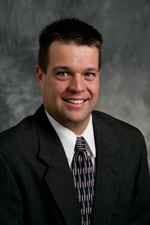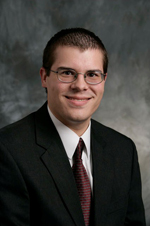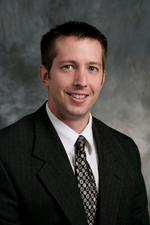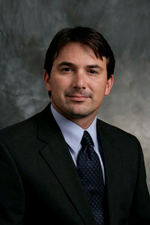|
|
The program means UNMC — and Nebraska — get to keep residents who previously would have gone to other states to pursue training in the emergency medicine specialty. A resident is a physician — usually a recent medical school graduate — who spends three to six years gaining required, specialized training in a specific area of medicine.
Nebraska already has reaped benefits since the 2004 launch of the emergency medicine program — the first of its kind in the state.
Utah native and resident in the program, Marion Bishop, M.D., Ph.D., grew up and lived in rural areas and large cities, including New York City. She went to medical school in Utah, but when she chose to specialize in emergency medicine, she knew she’d have to leave Utah because at the time, the school had no residency program.
One of the sites she applied to was UNMC. During her visit for an interview, she decided she liked Nebraska and its people. She was also attracted to the residency program’s rural rotation component.
“The chance to practice rural medicine was an appealing part of this residency,” Dr. Bishop said. “Some of the most unsung ER practitioners aren’t in big cities.”
Currently 18 residents are enrolled in the 3-year program. Six residents are accepted each year. Next year, the first class of physicians will graduate from the program.
Mike Wadman, M.D., director of the program and associate professor of surgery, said the program is working well.
One goal of the new program is to provide residents with outstanding clinical and educational experiences in emergency medicine. Another goal is to encourage more board-certified physicians to choose rural practices.
Nebraska stands to gain more emergency medicine physicians, particularly in rural areas. As research suggests, once residents graduate from their residency programs, they often choose practices near where they served residencies.
As part of the program, residents serve two, one-month rotations at Regional
West Medical Center under the direction of Peter Meyer, M.D., rotation supervisor, UNMC Emergency Medicine Residency Program, and director of the Regional West’s emergency department.
The remainder of the residency is spent at the emergency department at The Nebraska Medical Center in Omaha, UNMC’s hospital partner, and one month at the pediatric intensive care unit Children’s Hospital in Omaha.
“From the start, Dr. Meyer and the hospital have done everything they can to make this program successful, including helping the residents find housing and relocate for a month. Some have taken their families with them. They’ve done everything they could to make this a smooth transition,” Dr. Wadman said.
Dr. Wadman said a report card by the American College of Emergency Physicians supports the need for more board-certified ER physicians in rural Nebraska.
“There’s a disproportionate number between those serving in urban areas and those serving in rural areas,” Dr. Wadman said. “We recognized that here at UNMC and realized we needed to do something about it.”
Board-certified programs set rigorous standards and ensure high-quality training. Board certification requires members to take and pass a written and oral exam.
Dr. Meyer said when many residents first go to Scottsbluff for a rotation, they think they’re going “to the middle of no where.”
The city, however, often exceeds the residents’ expectations, he said.
“Scottsbluff is the largest community in the panhandle and I think all the residents have been pleasantly surprised. I think everybody who’s been here likes it,” he said.
Regional West is a Level II trauma center that receives emergencies from a large area, including parts of South Dakota, Colorado and Wyoming. The ER treats minor conditions as well, Dr. Meyer said.
“We see a lot of patients who should be seen in a family practice setting. It’s difficult for some people to get into the doctor’s office,” Dr. Meyer said.
Unlike many emergency rooms in larger cities, patients rarely wait to see a doctor at the Regional West ER.
“We get them in and out in two hours,” Dr. Meyer said. “I think the residents are impressed with how fast things can get done out here.”
He said one of the reasons for the efficiency is the good relationship the ER doctors have with the medical staff in and outside the hospital.
“It’s a small enough center that we know each other. It’s a pretty congenial atmosphere,” he said.
Dr. Wadman said the ER at Regional West Medical Center is a great place to train residents in rural emergency medicine.
“They have five board-certified emergency medicine physicians to staff the ER,” Dr. Wadman said. “That’s a rarity for that many to be credentialed considering the size of Scottsbluff.”
Ben Fagot, M.D., UNMC emergency medicine resident, has completed two rotations in Scottsbluff. The York, Neb., native said he has already signed a contract to work at the Great Plains Regional Medical Center in North Platte, Neb., when he graduates from residency next year.
“The ER in Scottsbluff can be as busy at times as Omaha, but in general it isn’t as hectic. There’s a more laid back atmosphere. It helps keep the stress level down a little bit. I hadn’t been to Scottsbluff before. I think it’s a really neat community. It has different things to do — more hiking and outdoor activities,” Dr. Fagot said. “The landscape is beautiful. It’s not the hustle and bustle of the big city.”
Dr. Bishop enjoyed her Scottsbluff rotations and is considering a rural practice after graduating from residency.
“The town I grew up in had more cows than people. I was excited to be in a rural setting again,” she said. “There’s something about small town life.”
Dr. Wadman said efforts are under way to work with other hospitals to serve as residency rotation sites in order to increase the number of physicians in ERs across Nebraska.
“One of our intentions with this program is also to give residents an insight into what rural emergency medicine involves and hopefully encourage more to seek positions in rural ER medicine,” Dr. Wadman said. “I think it’s working out the way we expected.”





